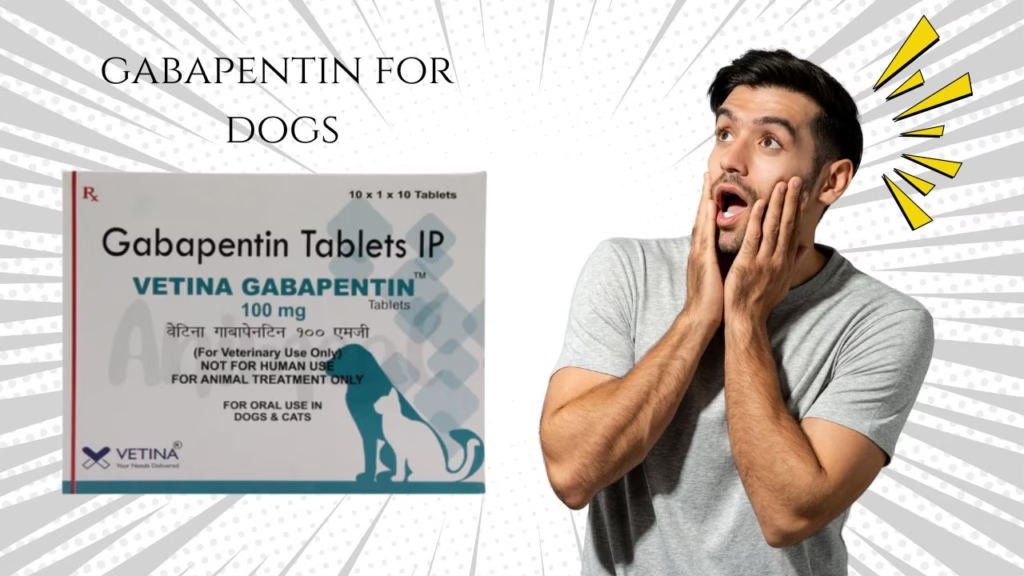What is Gabapentin for dogs, and how does it work?
Gabapentin, commonly known as Neurontin, is a medication used to treat various conditions in dogs, including pain, anxiety, and neuropathic pain. It works by affecting the nervous system, reducing the calcium flow in nerve cells, which helps manage nerve pain and has mild anti-seizure effects. Its calming properties also reduce excitement and can induce sedation, making it useful in treating stress-related issues.
For a broader perspective on safe pet medications, see Can Dogs Take NSAIDs for Pain?.

While Gabapentin is FDA-approved for human use, it’s prescribed off-label for pets, which means it’s not officially approved for use in animals. Veterinarians may prescribe it for dogs, but it is considered a Schedule 5 controlled substance, meaning it’s federally regulated. In some states, there may be restrictions on its prescribing and distribution, so it’s important to follow the vet’s guidance for safe usage.
What Is Gabapentin Used for in Dogs?
Gabapentin, a human medication, is commonly used in veterinary medicine to treat various conditions in dogs. While it’s FDA-approved for humans, it is often prescribed off-label for pets, particularly to manage pain, seizures, and anxiety. For dogs suffering from nerve pain or post-surgery discomfort, Gabapentin can offer significant relief. Additionally, it’s effective in controlling seizures and calming anxious behavior in dogs, making it a valuable tool for managing a range of health issues.
For pain management in dogs, you might also find the Best Arthritis Medicine for Dogs helpful.
Preventing Seizures
Gabapentin is a valuable medication for dogs suffering from refractory seizures, particularly when other treatments are not fully effective. With its anticonvulsant properties, Gabapentin works as an adjunctive therapy, enhancing the effects of primary seizure medications and helping to control seizures more effectively.
It can be an important part of a comprehensive regimen for dogs with chronic seizure conditions, providing additional support when other treatments fail to manage the symptoms completely. When used alongside other therapies, Gabapentin can help improve seizure control and benefit dogs who struggle with seizure management.
Learn more about other seizure management options at Pregabalin for Dogs: Safe or Dangerous?.
Controlling Pain
Gabapentin is an effective analgesic that provides relief for dogs suffering from chronic pain, especially those with conditions like neuropathic pain or degenerative joint disease. It is particularly useful for managing pain associated with arthritis, offering a valuable alternative when nonsteroidal anti-inflammatories or opioids alone are insufficient.
Often used in combination with other pet medications, Gabapentin helps to enhance the overall effectiveness of a pain management plan, especially in post-surgery care. By targeting nerve pain and offering long-lasting relief, it ensures a better quality of life for dogs dealing with ongoing discomfort.
You can explore other pain management options in Naproxen for Dogs: Pros, Cons, and Safe Alternatives.
Easing Anxiety
Gabapentin can be highly effective in easing anxiety in dogs, especially for those dealing with specific triggers like thunderstorm phobia or stress from vet visits. This medication works by influencing excitatory neurotransmitters in the brain, helping to reduce the overwhelming feelings of anxiety.
When administered, Gabapentin offers anxiety relief, giving your pup a more chilled-out feeling and allowing them to better cope with common stressors. It’s often used alongside other tools like a Thundershirt or calming pheromones. When combined with professional guidance from your vet, it can be an effective way to treat your dog’s anxiety.
If you want more anxiety management tips, check out Dog Itching Remedies That Bring Instant Relief.
What is the dosage of Gabapentin for dogs, and how is it given?

- The dosage of Gabapentin depends on the dog’s weight and the condition being treated, whether it’s for pain management or anti-seizure medication.
- A veterinarian must determine the proper dosing, as variability exists in how dogs respond to the medication.
- Gabapentin is usually given orally in capsules, tablets, or liquid form.
- Capsules may be difficult for some dogs to swallow, so they can be mixed with soft food or used as a treat to make administration easier.
- Liquid gabapentin can be flavored, especially for small dogs, to improve palatability and ease of use.
- Be cautious not to use human versions of Gabapentin, as they may contain xylitol, which is toxic to dogs.
- In some cases, a compounding pharmacy may provide a customized liquid form if needed. Always consult your veterinarian for the appropriate form and dosing for your dog’s needs.
For more on pet medications and dosages, check out Accurate Doxycycline Dosage Chart for Dogs.
What’s the Gabapentin Dosage for Dogs?
The gabapentin dosage for dogs typically falls within a dosage range prescribed by your veterinarian, depending on the condition being treated. For pain or seizure management, the dosage is often administered two to four times per day.
Human-labeled products, such as 100 mg capsules, 300 mg capsules, or even 400 mg capsules, may be used, but it’s crucial to consult with your vet for the correct dosage. Oral solutions, like 250 mg/5 mL, are also available, though it’s important to ensure that the solution doesn’t contain xylitol, which is toxic to dogs.
If your dog has difficulty swallowing capsules, it’s often easier to mix the medication with food or use a liquid form to help with administration. In some cases, a compounding pharmacy may provide customized forms of Gabapentin if your pet needs a different strength or flavor.
Dogs with kidney or liver impairment may require an adjusted dosage to avoid side effects, and discontinuing the medication suddenly may lead to withdrawal seizures. Always follow the directions given by your veterinarian to ensure the impact is optimal and your dog gets the relief they need.
How to Give Your Dog Gabapentin
When giving Gabapentin to your dog, it is usually available as an oral medication in forms like 100-milligram, 300-milligram, or 400-milligram pills. While human versions of Gabapentin may be used, they often require adjustment in dosage for your pet’s needs.
If your dog struggles with swallowing pills, you can use a liquid form or even get a dog-safe liquid through a compounding pharmacy, which might offer smaller pills or flavors that are easier to administer. Be cautious of any liquid containing xylitol, as this ingredient is unsafe for dogs and can cause serious health problems.
- Follow your veterinarian’s instructions for timing and dosage to ensure maximal effectiveness.
- Gabapentin is typically given two to three times a day and can be taken with food to ease administration.
- The effects of Gabapentin generally start within one to three hours and can last up to 24 hours, depending on the dose.
- If your dog has liver or kidney problems, the dosage may need to be adjusted.
- Always consult your veterinarian before making any changes to your dog’s medication routine.
What are the common side effects of Gabapentin in dogs?
Gabapentin can have a few side effects when used in dogs, especially at higher doses. The most common reactions include sedation, lethargy, and tiredness, which can affect the dog’s daily function. Some dogs may also experience poor balance, difficulty walking, or even ataxia, a lack of coordination.
These effects typically wear off after 8 to 12 hours, but may be more pronounced when the dose is higher or the dog is sensitive to the medication. Less common side effects include vomiting and diarrhea, which can be managed by adjusting the dose or changing the form of Gabapentin. If you notice any unusual symptoms, it’s important to contact your vet for advice on how to reduce or adjust the dose for your dog’s comfort and safety.
For other side effects and safety guidelines, see Mefenamic Acid for Dogs: Minimize Side Effects.
What are the most serious risks of Gabapentin for dogs?
- Serious side effects: When given at higher doses, Gabapentin can cause sedation, problems with walking, and balance issues, making it harder for the dog to move safely.
- Liver or kidney disease: Dogs with significant liver disease or kidney disease may metabolize Gabapentin differently, causing it to take longer to wear off, which could result in prolonged sedation or other side effects.
- Pregnant or lactating dogs: Gabapentin should be used cautiously in pregnant dogs or those that are lactating, as it may pass through the placenta or into the mother’s milk, potentially affecting the fetal pups or nursing pups.
- Xylitol poisoning: If a human liquid formulation of Gabapentin is accidentally given to a dog, it may contain xylitol, an artificial sweetener that is toxic to dogs, leading to poisoning even in small amounts.
- Accidental administration by family members: Well-meaning family members may unknowingly give the wrong form of Gabapentin to the dog, such as a human version, which could lead to harmful consequences. Always keep human medications out of reach of pets.
- For more on medication safety, check out Clavamox Dosage for Dogs: How Much is Too Much?.
Can a dog take too much Gabapentin?
Yes, a dog can take too much Gabapentin, and doing so can lead to serious side effects, some of which can be life-threatening. Overdosing on Gabapentin can cause severe sedation, lethargy, and, in extreme cases, it may affect the dog’s nervous system and lead to a serious illness. It’s crucial always to follow the veterinarian’s instructions regarding medication and dosage.
If you suspect your dog has ingested too much Gabapentin, especially if it’s in the form of oral liquid solutions intended for humans, it could also contain xylitol, which is toxic to dogs. If this occurs, contact your vet immediately or call the pet poison hotline for advice on how to handle the situation. Always store medications safely, away from your pets, to avoid accidental ingestion.
Does Gabapentin interact with any other dog medications?
- Antacids: Antacids containing aluminum, magnesium, or calcium can reduce the absorption of Gabapentin, making it less effective.
- Central Nervous System Depressants: Medications like alprazolam (Xanax), phenobarbital, acepromazine, and opioid pain medications such as tramadol and codeine can have an additive sedative effect when used with Gabapentin, increasing the risk of drowsiness or lethargy.
- Cannabinoids: Cannabidiol (CBD) may enhance the effects of Gabapentin, leading to a higher risk of side effects.
- Veterinary direction: Always use Gabapentin under veterinary direction when your dog is on other medications, as the dosing or frequency may need to be adjusted to avoid harmful interactions.
For further information on medication interactions, visit Is Pradofloxacin for Dogs and Cats Right for Your Pet?.
Can You Use Gabapentin and Trazodone Together for Dogs?
Yes, Gabapentin and Trazodone can be prescribed together for dogs, often when managing pain and anxiety simultaneously. Gabapentin is commonly used to help with easing anxiety related to pain. At the same time, Trazodone is an anti-anxiety medication that helps reduce stress, particularly during vet visits or post-surgical confinement when a dog may need to rest. When these two medications are combined, they can provide comprehensive support for both pain management and anxiety relief.
While generally safe when prescribed together, the dosing should be carefully managed by a veterinarian to avoid any potential side effects from sedation or excessive drowsiness. It’s important to follow your vet’s guidance on how to administer these medications to ensure the dog receives the most effective and safest treatment.
Is Gabapentin Safe for Dogs?
When considering Gabapentin for dogs, it’s crucial to follow the veterinarian’s advice closely. This effective drug is commonly prescribed for pain, anxiety, and seizures, but it must be administered with care. Dogs’ bodies process medications differently, and Gabapentin is metabolized through the kidneys and liver.
This means dogs with compromised organs require extra caution. Additionally, some liquid gabapentin forms contain xylitol, an artificial sweetener that is toxic to dogs and can even be fatal. Always check the ingredients and consult your vet before giving it to your pet.
While Gabapentin is generally safe when used at recommended doses, it’s important to watch for side effects like sedation or loss of coordination, especially when the drug is used for the first time. Higher doses, such as 30 milligrams, may cause prolonged side effects, so monitoring your dog closely is essential. Be mindful of any interactions with other medications, like opioids (e.g., hydrocodone, morphine) or antacids, which can affect absorption and metabolism. For safe long-term use, adjusting the dosage and keeping track of your dog’s blood values is always recommended.
What should you do if your dog misses a dose of Gabapentin?
If your dog has missed a dose of Gabapentin, don’t panic. Give the dose as soon as you remember, but if it’s almost time for the next dose, skip the missed dose to avoid giving too much medication too soon. Gabapentin works best when given at regular intervals, usually 8 hours apart, and increasing the dose or trying to catch up on a missed dose can lead to unnecessary sedation or other side effects. If you’re concerned about how this might affect your dog, especially if it’s used for pain management, reach out to your vet for advice.
Summary
When it comes to Gabapentin for dogs, it’s important to follow your veterinarian’s guidance carefully, especially when it comes to dosing. If you accidentally miss a dose, don’t try to make up for it by giving the medication too soon. Instead, administer the dose as soon as you remember, but if it’s nearly time for the next dose, skip the missed one to avoid any sedation or other side effects that could arise from an increased dose.
Gabapentin works best when given at consistent intervals, usually 8 hours apart, and maintaining a steady routine is crucial for managing pain or anxiety in your dog. If you’re ever concerned about the missed dose or your dog’s response to the medication, reaching out to your vet is the safest course of action.



Pingback: Gabapentin for Dogs: 11 Must-Know Essential Facts About Dosage, Benefits & Side Effects – petdepth.com